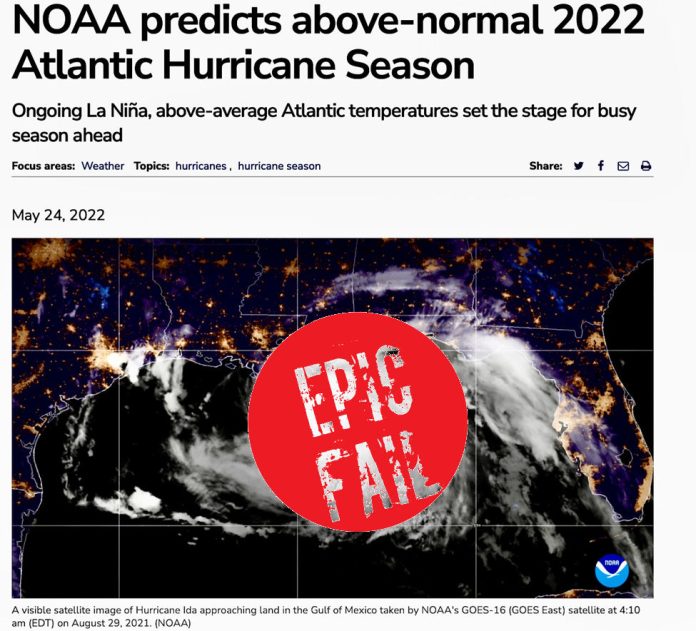Editors Note: Readers may recall that Climate Realism brought attention to the claims and the failures of the media in covering the 2022 Atlantic hurricane season here, here, and here. Now that the hurricane season is over, this guest essay summarizes the complete failure of the huricane season claims based on computer models predicting an active season.
Guest essay by Larry Hamlin
In late May and again in early August 2022 NOAA predicted that the year 2022 Atlantic Hurricane Season (between June to end November calendar period) would be an “above normal” season with 14-21 named storms, between 6-10 hurricanes including 3-6 major hurricanes (Category 3,4 and 5) as shown in NOAA’s diagram below.
Colorado State University’s Department of Atmospheric Science/Tropical Meteorology Project has compiled the year 2022 tropical storm data (shown below) establishing that compared to its 30 year North Atlantic data records covering the Climatological period 1991-2020 the year 2022 hurricane season was below average in Named Storms, Named Storm Days, Hurricane Days, Major Hurricanes, Major Hurricane Days and Accumulated Cyclone Energy (ACE).
The NOAA prediction was far off base regarding major hurricanes with only 2 occurring during the season versus the 3-6 predicted range and only a total of 14 storms which was at the very lowest end of their predicted 14-21 range.
The 2022 Atlantic Hurricane season ended with only 78% of the average ACE recorded compared to its 30-year climatology average ACE during the 1991-2020 period. The 2022 ACE level is 60% lower than occurred during the six-year period inclusive of 2016 through 2021 despite climate alarmism hyped propaganda the the world is experiencing a “climate emergency.”
The Colorado State University graph below shows the year 2022 Atlantic Hurricane season below average ACE outcome compared to 30-year climate average period between 1991-2020.
The year 2022 Atlantic Hurricane data for each of the 14 named storms is shown below with the names, specific dates of occurrence, maximum wind speed and total storm ACE provided.
Note that major hurricane Ian’s maximum wind speed is identified as being 135 kts.
The Colorado State University report identifies the following information regarding its assessment of maximum wind speed. “Track history for each storm is created from the operational warnings that are issued every six hours by NHC, CPHC , and JTWC . The positions and intensities are best estimates of those quantities when the warning is issued. THESE ARE NOT BEST TRACKS – having not been reanalyzed in any systematic manner.”
The Best Track history for major hurricane Ian is provided below showing the 135 kts maximum wind speed.
As always occurs each Atlantic Hurricane season the climate alarmist propaganda media continue to misrepresent Atlantic Hurricane data in ways that falsely portray the apparent strength and frequency of hurricanes to push their climate alarmist agenda as illustrated by recent (with cherry-picked hurricane history and hurricane category as well as ignoring hurricane days and hurricane ACE data) efforts by the New York Times as shown below.
Colorado State University data for the long term North Atlantic history providing complete records of major hurricanes, major hurricane days and total ACE are shown below.
The data shows that alarmist claims of increasing climate driven trends for recent major hurricanes in the North Atlantic are unsupported by actual data with varying hurricane behavior present throughout the century. This outcome is particularly noteworthy since Geostationary Operational Environmental Satellites (GOES) did not begin operating until the mid 1970s which significantly increased scientists’ ability to detect and monitor global tropical storms and hurricanes.
Additional scientific assessments of ACE data shown below clearly establish that there are no recent climate change driven increases in tropical storms, hurricanes or major hurricanes with these outcomes demonstrating natural climate behavior is driving these outcome patterns.
The data presented here is always concealed by politically contrived climate alarmist propagandists as demonstrated by the New York Times hurricane propaganda chart presented earlier.
NOAA’s Geophysical Fluid Dynamics Laboratory (GFDL) concludes the following regarding climate change and hurricanes.
“In summary, it is premature to conclude with high confidence that increasing atmospheric greenhouse gas concentrations from human activities have had a detectable impact on Atlantic basin hurricane activity, although increasing greenhouse gases are strongly linked to global warming… Human activities may have already caused other changes in tropical cyclone activity that are not yet detectable due to the small magnitude of these changes compared to estimated natural variability, or due to observational limitations.”
Of course, the New York Times and other climate alarmists will continue to push the flawed and scientifically unsupported Democrat politics of climate alarmism.





























